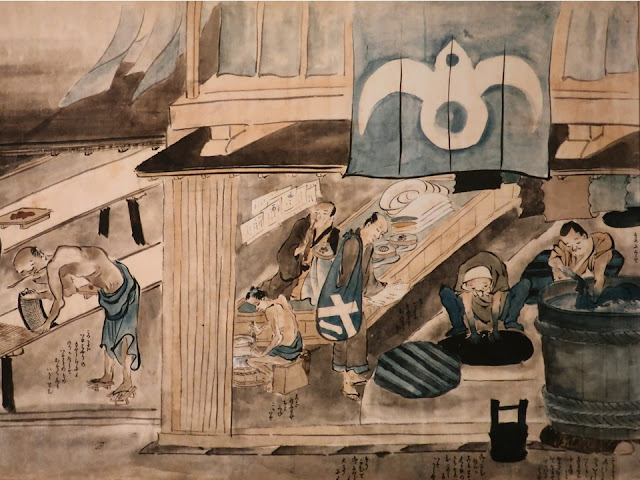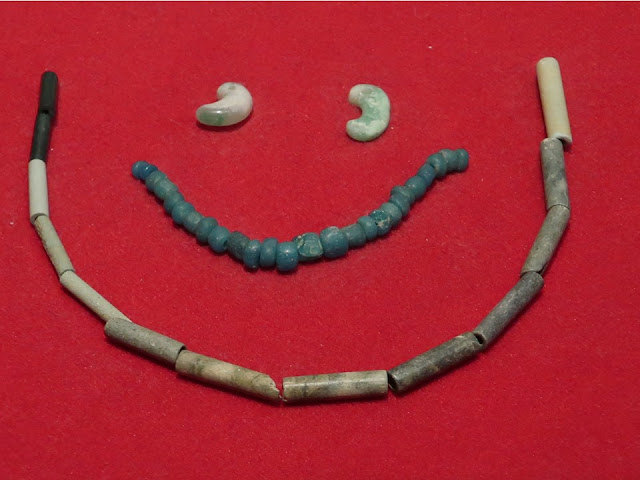This big museum is in Taga city which is
located around 350km north of Tokyo. Yamato Dynasty, which was ruled by the ancestor
of the Japanese emperor, established the regional HQ here. Therefore, Taga was a central
city of Northeast (Tohoku) Japan. Tohoku history is exhibited tidily. I like
here because people’s livelihood in every era is exhibited. We can also enter
the old and big farmer’s house which was brought from the neighboring area
Ishinomaki and reconstructed in the ground of this museum.
The exhibits of accessories and
festivals show me the enjoyment of people. Moreover we can see lots of exhibits about
travels which was the amusement of ordinary people in the Edo period.
67 pictures are uploaded.
 |
| Permanent exhibition room、常設展示室 |
大和朝廷が東北を支配するために置いた陸奥の国府・多賀城跡の近くにある大きな博物館。縄文時代からの東北の歴史が整然と展示されている。どの時代の展示にも人々の暮らしのコーナーを設けていて、民俗学的にも分かりやすい。多賀城があった時代、奥州藤原氏の時代、伊達氏の時代を中心にした展示であった。博物館には、石巻市から移設された見ごたえがある今野家住宅もある。
人の楽しみの面からみると、アクセサリーと祭りの展示が充実していた。支配者階級となるが古代の美しいアクセサリー、漆製品、祭りに使う藁人形が展示されている。また、江戸時代の楽しみは旅、ということで旅に関する展示もまとまっていた。
Ancient 縄文時代・弥生時代
After the glacial period, it became easier for creatures to live. The Jomon period started then: it was around 13,000years ago. It was written that people cooperated in gathering food like nuts, also fishing and hunting.氷河時代が終わり、生物が棲みやすくなった1万2・3千年前に縄文時代が始まった。縄文時代は稲作が始 まる紀元前4世紀ごろまで続く。縄文時代は、人々は協力して、木の実などの食料を採取し、狩猟や漁を行った、とある。
Dogs
were buried like human beings; Dogs have been our partners since ancient time.
犬は人と同じように埋葬された。犬は古来からのパートナーだ。
 |
| Inside the house @ The Jomon period、縄文時代の家の中 |
Accessories
アクセサリー
These show me the passion of dressing up.
古代の人のおしゃれしたい気持ちが伝わる
The doll
wears imitation accessories, so we can imagine easily; beautiful accessories
are in the glass case.
人形が身に着けており、イメージを掴みやすい。ケースには美しい品々が展示されている。
 |
Ornamental hairpins made of antler which
is designated cultural assets、角製簪
|
 |
Shark tooth necklace in 3,000 years ago
|
 |
Pendants
made of jade、ペンダントに使われたヒスイ
|
 |
| Earthen earring、耳飾り |
These
elaborate rings are found from the ruin in Zaoh around 4,000 years ago.
蔵王町にある4000年前の遺跡から発掘。細かい意匠が施してある。
Festival 祭りの道具
The main purposes of festivals were to pray
for harvest and birth. Most of exhibits are replicas, however, they show me their
wish. I think festivals were not revels but serious ones probably. They would have
offered victims.
食料を収穫できることを祈り、子が増えることを祈るのが主な目的だったようだ。複製品が大半だが、昔が偲ばれる。今の祭りように、どんちゃん騒ぎではなく、シリアスなものであったと思う。生贄も捧げただろうし。
 |
| Human shaped lay figurine with goggles、遮光器土偶 |
This is a female doll which was used for safe
delivery and prosperity of descendants.
土偶は、女性の形をしており、安産や子孫繁栄を願うために使われたとある。目の表現が北方の人が使う雪メガネに似ていることから遮光器土偶と言うらしい。
 |
| Replicas of animal shaped clay figures、動物の土製品の複製 |
Wild
boars were popular because of fertility. Animal with human face is interesting.
イノシシは多産で人気があったという。人面獣が面白い。
 |
| Rice farming in Yayoi period、弥生時代の米作り |
Yayoi
period started in the 3rd century B.C. which was a farming period.
弥生時代。紀元前三世紀からは農耕の時代になる。
 |
| Japanese lacquer ware、漆製品 |
These
are replicas but their beauty, which is based on high skills, astonished me.
稲作前の時代に、こんなに高い工芸技術があったのかと思う。複製品だが、何れも美しい。
 |
| Haniwa which were buried together with dead bodies of powerful families、埴輪 |
The
powerful families started ruling each region; that era is called Kofun (ancient
tomb).
These
necklaces were made in the 4th century. I think they are sophisticated.
4世紀のネックレス。洗練されてきていると思う。
 |
Presumptive
drawing of the rite at that time and instruments for the rite
まつりの様子と祭りに使われた土器
|
The
model of the regional HQ of Yamato Dynasty which was established in 724; it is
called Taga castle.
724年から設置された多賀城の模型。
 |
Instruments
of rituals and incantations from 9th to 10th century、
9~10世紀の祀りと呪術の道具
|
Medieval era 中世・近世
Straw Images of Tohoku Deities Guarding Village村におけるワラの神々
 |
Straw images of deities of village
borders、
村境を守る人形様
|
 |
Deities of driving insect pests out of
the village、
害虫を送り出す神
|
 |
Deities
of purging pestilence、
疫病を送り出す神
|
It is written on the caption “Smallpox
and other plague were considered to be carried by evil spirits. Villagers made
straw representations of those spirits and sent them away from the village
border with prayers not to infect the village.” It is also written on the
caption of National
Museum of Ethnology “People’s wish is put into the straw rope”.
Straw
which are by-product of rice is very special for Japanese.
疫病神をワラ人形に封じ込めて、村境に放置したり、川に流したりした。団子を作って体の悪いところを擦り、人形に持たせて送り出す例もあったという。国立民族学博物館では、“藁を使った縄は思いの込められた造形となる”と書かれていた。
 |
Masks
and outfits of deities who visit the village and houses、
訪れてくる神々・なまはげなど
|
Sendai city 仙台市中
 |
Downtown of Sendai city which has been the central city of Tohoku region
since the Edo period、
江戸時代の街の様子。賑わっている
|
 |
| Guidebooks and a how-to book、ガイドブックとノウハウ本 |
There were many bookstores in Sendai. Books such
as Confucianism were published, so this city contributed to improve the local
culture so much. Cultural books or practical books were published a lot, and guidebooks
of Tohoku were also published. Reading is fun; Notably, the literacy rate
was high even in the Edo period.
仙台には本屋が軒を並べ儒学、詩文などを出版し地域文化の発展に大きな役割を果たした。特に、往来物と言う一般向けの教養書は多数出版された。松島など東北の旅行案内書も出版されたとのこと。本を読むのは楽しい。日本人の識字率が高かったのがキーだ。
 |
Manners
and how –to book for girls which was published in 1822、
女大学は女子の心得を記すノウハウ本
|
 |
Text of
agriculture (1697): I respect farmers who could read this book.
農業のハウツウ、農業全書。これが読めたのだからすごい。
|
 |
Map of
Dewa Mountains which have been popular among pilgrims (1853).
修験者に人気の出羽三山の絵図
|
 |
| Guidebook of Ise (1797)、伊勢名所図会 |
 |
Destination
of pilgrimage for Tohoku inhabitants: They visited spots mainly in Tohoku region.
東北の人たちの参詣地。やはり、東北が多い
|
 |
Catching
“Bell-Ring” insects in Miyagino is introduced in the guidebook of Sendai. It’s
graceful.
ガイドブック系「奥州仙台名所尽集」の宮城野の鈴虫捕り。優雅だ。
|
 |
| Entertainment in Town、花見 |
The caption states “Sendai offered
various entertainments such as theater performances and sumo wrestling. People
enjoyed festivals as well as sakura cherry blossom viewing in the spring, hagi
flower viewing in the autumn. The Toshougu Shrine festival featuring dozens of
floats attracted visitors from neighboring areas.”
町場の楽しみとして、「季節ごとの祭りや芝居・相撲の興行などいろいろな娯楽があった。仙台城下の人々も神社の祭礼をはじめ、春の桜・秋の萩などを楽しんだ。特に東照宮の祭礼は、数十台の山車が練り歩く大規模なもので、近郷からも多くの人々が見物に訪れ、町場はにぎわった」とある。
Business 商工業
 |
| Dyed fabric are so beautiful、美しい染物 |
 |
| Craftsman in the dye work、染屋の職人 |
 |
Ranking of local specialties across Japan
made by the Kyoto merchant、
京都の店が作った物産番付、諸国物産見立相撲番付
|
Matsumae
konbu (kelp) is in the first place followed by the dried bonito of Tosa. Many
products such as the kitchen knife of Sakai are listed too. Shopping is an
eternal fun. Specialties were made all over Japan.
東の大関が陸奥の松前昆布、西の大関が土佐の鰹節。堺包丁など食べ物以外も多い。買い求めるのも楽しみだ。各地で特産品の製造が盛んになった。
 |
| Specialties in Tohoku、東北の特産品 |
 |
Paper currency which was valid only in
Sendai-han area and common currency、
仙台藩藩札と一般通貨
|
Fishery and Agriculture 漁業と農業
 |
| Fisherman’s outfit and tools、漁民の作業着と道具 |
It is simple and looks like the hero of the famous folk tale Urashima Taro.
浦島太郎のような素朴ないでたちだ。
 |
| Socks for rocky places、イソタビ |
Those were used in order to take seaweeds and shells,
so they are strong enough to protect fisherman’s feet.
「岩場で海藻や貝を取る時に、けがをしないように刺し子をしたタビにワラで作ったゾウリをはいた」とある。
There are
models of rice farming people which are really good to understand how to work
without machines. The photo above shows the work to remove thorns from paddy. I
uploaded the detail on the other article.
稲作の様子の模型。分かりやすい。上記の記事で別途紹介。籾の刺などを取っているところ。
 |
| Killing her baby Mabiki、間引き |
Summer temperature doesn’t raise enough to
grow rice sometimes, it brought the poor crop and famine. Some farmers killed
their children to live. This wooden board was offered to the shrine to pray to
stop killing a baby.
東北は、夏の気温が上がらないときがあり(やませ)、飢饉に見舞われる。哀しい間引きが行われた。それを戒めた絵馬がある。
Farmer’s
riots broke out often because of heavy tax.
重税に不満を持つ、農民の一揆も多発した。
Modern period 近代
 |
Flag of
the allied force of Tohoku Daimyos
奥羽越列藩連合の旗
|
Daimyos in Tohoku supported Tokugawa Shogun, however they were
defeated by the Emperor’s military. The Edo period was ended and the
Meiji period started.
徳川の時代は終わり、明治となる。
Sendai-han
was also defeated and the members crossed Tsugaru Strait and moved to
Hokkaidou, but life was not easy.
政府軍に敗退した仙台藩の人々の北海道移住の様子。明治時代。
On the
other hand, new era started and new movement “Cultural Enlightenment 文明開化”, which was
Westernization essentially, started too.
The
chonmage topknot was forbidden by the ordinance in 1873. It was really traditional
hairstyle of Japanese men in the Edo period, but it was extremely different
from Western hairstyle.
明治6年の散髪令。ちょんまげは禁止となった。
The
painting above was made in 1883, however we can find a foreign lady on a horse,
chonmage hairstyle men and many Japanese half-naked workers. This shows
Japanese were still uncivilized; the society westernized slowly. By the way, I
would like to point out that uncivilized doesn't mean wicked.
江合川船着き場の絵馬(明治16年)には、半裸の人足、ちょんまげ、外人もいる。でも、時代はだんだんと変わっていく。
 |
| Magazines around 1920、大正、昭和期の雑誌 |
 |
| Brochures issued by movie theater and train tickets in Sendai, around 1920 |
 |
| Attractive poster of kimono clothes shop |
 |
| Difficult life during World War 2 |
 |
Full
scale model of a variety store around 1965、
私が6歳のころの雑貨屋
|
I was only six in 1965, this store brings back
old memories.
1965年、こんな店だった。
 |
| Inside the store、店内 |
This shop is similar to the convenience store
in present. However, many handmade foods, such as Senbei rice crackers and
bread, are sold. It is written “Confectionery made in factories and detergents
are new items of the local store in 1965.”
店内。手作りのせんべいやパンなどが多いが、一部、工業生産のお菓子や洗剤が並んでいるのが特徴と言う。いまは、コンビニで工業製品ばかりだ。
The farmhouse of Konnos 今野家住宅
The volunteer guide told me that this house
was donated by the owner who was an acquaintance of the president of this
museum 20 years ago. It is too difficult to maintain the big house like this
because it cost around $200,000 only to renew the thatched roof. In the Edo
period, villagers helped one another to change the roof. It is difficult to keep
and maintain the farmhouse, so this is an icon of mutual aid in the village.
ボランティアの方(guide)によると、今野家住宅は、館長の知り合いであった今野さんが、20年前に博物館に寄贈したらしい。これだけ大きな家になると個人では維持できなくなったようだ。移築に1.9億円かかり、屋根の葺き替えには二千万円かかっているという。かつて、屋根の葺き替えは村人が相互に行ったが、村としての協力がないとこのような家を維持するのは困難だ。
 |
Talismans
on the
wall of the earth floor. It’s indigenous in Tohoku.
土間の摩除け。東北の特徴らしい。
|
 |
The
hanger of the pot is so big, family members gather around Irori fire place.
立派な自在鉤、家族が集まる。
|
Villagers
had events here such as wedding ceremonies. Here was a community center. There is a living room behind this guest room.
村の人の祭りの間、結婚式などいろいろなイベントが行われたという。公民館でもあったのだ。奥は主人夫婦の居室。
The photo
above shows the view of the room for samurai government officials from the
owner’s office. Sendai-han didn’t allow to install ceilings because farmers hid
rice over the ceilings. I don't know whether it was based on thrift policy
or not.
肝いりである主の執務室から、侍用の和室。仙台藩は、畳も天井も禁止していたとのこと。天井裏に米を隠すからと言うが、本当か。贅沢禁止の影響か。
 |
| Utensil, set of seven boxes、7組の重箱 |
The details
about this house and exhibits are written the site below.
http://www.thm.pref.miyagi.jp/media_files/cms/upfile/131/English%20Guide%20(Konnos).pdf
Vestige of Taga Castle; Regional HQ of Yamato Dynasty 多賀城跡
This stone
monument "Tsubo no Ishibumi" was built in 762 which announced the renovation of Taga Castle. Very
famous Japanese poets such as Saigyou(1118-1190) and Bashou(1644-1694) visited here and wrote poems.
多賀城碑/壺碑(つぼのいしぶみ):奈良時代762年に作られた改修の記念碑。西行、芭蕉をはじめ多くの歌に詠まれている。
 |
| Way to Taga Castle、多賀城への道。人は少ない。 |
 |
Vestige
of the main hall of HQ on the top of the hill、
丘の上の政庁本殿跡
|
 |
| Return to my home Sendai station and bullet trains、仙台駅の新幹線ホーム |
15 funs(楽fun)were found. Visited in
July, 2018
Website:
http://www.thm.pref.miyagi.jp/index.php (in Japanese)
Previous post ((Museum in the castle city
of northern Japan):
Next post (Travel diary of British lady in Tohoku,
more than one hundred years ago, that's exciting) :




















Comments
Post a Comment